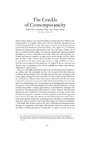The Crackle of Contemporaneity
| dc.contributor.author | Cox, Geoffrey | |
| dc.contributor.author | Prior, Andrew | |
| dc.contributor.author | Nolan, R | |
| dc.contributor.editor | Schwab M | |
| dc.contributor.editor | de Assis P | |
| dc.date.accessioned | 2019-04-28T14:04:06Z | |
| dc.date.available | 2019-04-28T14:04:06Z | |
| dc.date.issued | 2019-07-15 | |
| dc.identifier.isbn | 9462701830 | |
| dc.identifier.isbn | 9789462701830 | |
| dc.identifier.uri | http://hdl.handle.net/10026.1/13749 | |
| dc.description.abstract |
There comes a time to move beyond asking the broad question “What is contemporaneity?” to consider more acute ways in which this question can be traced and signalled. We consider the notion of signal to be particularly appropriate in the consideration of contemporaneity, since signals are a constitutive element of contemporary infrastructures and our experience of time even if they are relatively undetectable. They operate underneath human perceptual thresholds as carriers, controllers, and codes, while also surfacing into perceptual and semiotic registers, as signs across various media—textual, visual, and, of course, sonic—all the while accessible as traces. Perhaps in this way it is possible to experience contemporaneity at a range of different scales— from the microtemporal to the planetary—to register both our closeness and distance from it (Agamben 2009), and to exemplify how times come together disjunctively in the present | |
| dc.format.extent | 97-114 | |
| dc.language.iso | en | |
| dc.publisher | Leuven University Press | |
| dc.relation.ispartof | Futures of the Contemporary: Contemporaneity, Untimeliness, and Artistic Research | |
| dc.rights | Attribution-NonCommercial-NoDerivatives 4.0 International | |
| dc.rights | Attribution-NonCommercial-NoDerivatives 4.0 International | |
| dc.rights | Attribution-NonCommercial-NoDerivatives 4.0 International | |
| dc.rights | Attribution-NonCommercial-NoDerivatives 4.0 International | |
| dc.rights | Attribution-NonCommercial-NoDerivatives 4.0 International | |
| dc.rights.uri | http://creativecommons.org/licenses/by-nc-nd/4.0/ | |
| dc.rights.uri | http://creativecommons.org/licenses/by-nc-nd/4.0/ | |
| dc.rights.uri | http://creativecommons.org/licenses/by-nc-nd/4.0/ | |
| dc.rights.uri | http://creativecommons.org/licenses/by-nc-nd/4.0/ | |
| dc.rights.uri | http://creativecommons.org/licenses/by-nc-nd/4.0/ | |
| dc.title | The Crackle of Contemporaneity | |
| dc.type | chapter | |
| plymouth.series | Orpheus Institute Series | |
| plymouth.organisational-group | /Plymouth | |
| plymouth.organisational-group | /Plymouth/Faculty of Arts, Humanities and Business | |
| plymouth.organisational-group | /Plymouth/Faculty of Arts, Humanities and Business/School of Art, Design and Architecture | |
| plymouth.organisational-group | /Plymouth/REF 2021 Researchers by UoA | |
| plymouth.organisational-group | /Plymouth/REF 2021 Researchers by UoA/UoA32 Art and Design: History, Practice and Theory | |
| plymouth.organisational-group | /Plymouth/REF 2021 Researchers by UoA/UoA32 Art and Design: History, Practice and Theory/UoA32 Art and Design: History, Practice and Theory MANUAL | |
| plymouth.organisational-group | /Plymouth/Users by role | |
| plymouth.organisational-group | /Plymouth/Users by role/Academics | |
| dc.publisher.place | Leuven | |
| dc.rights.embargoperiod | Not known | |
| rioxxterms.version | Accepted Manuscript | |
| rioxxterms.licenseref.uri | http://creativecommons.org/licenses/by-nc-nd/4.0/ | |
| rioxxterms.type | Book chapter |



